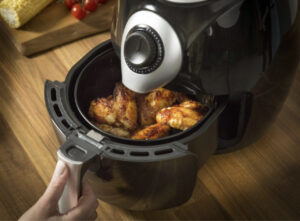Martin Lewis is back with another intriguing viewpoint on a widely used item.
He may have previously cautioned against using debit cards, but this time it’s the air fryer.
Sadly, there isn’t much evidence to support the useful electronic kitchen appliance.

Since the epidemic and the ensuing rise in living expenses, the air fryer has become very popular. Advertisements for the kitchen appliance claim that it is significantly healthier. They are also expected to cost less to operate on average than ovens. We could have overreacted to this little electric oven, and it might not be what it seems to be.
In a recent episode of The Martin Lewis podcast, Lewis highlighted that ovens can occasionally be less expensive than air fryers. Martin, who is now 50 years old, described how microwaves deliver even heat.
However, after they reach their maximum temperature, ovens only continue to produce enough heat intermittently to keep the desired temperature. Ovens do not operate at full power the entire time as a result.

Martin Lewis even describes a specific situation in which ovens prove to be significantly more economical.
“If you were doing a full roast dinner and you were cooking many [jacket potatoes], it’s probably cheaper [putting them in the oven] than putting five or six jacket potatoes in a microwave because each additional object you put in a microwave, you need to keep it on longer because a microwave just heats the individual object”

Don’t see this, though, as a complete indictment of the air fryer. If there were only one jacket potato instead of 10, like in the example above, the air fryer/microwave would undoubtedly win.
However, it is impractical for us to constantly calculate which alternative is more cost-effective for a specific quantity of food. Alternatively, can we?
The Mathematics Behind The Cost-Efficiency In The Kitchen
Martin Lewis actually offers an answer that will reveal the solution to the prior query as well as the underlying issue. “General equation is, find the wattage of an item, then work out how many kilowatts or what fraction of a kilowatt it’s using, then multiply that by 34p ($0.42) per hour of use. […]
The problem with the equation for heating equipment is an oven is going to be about 2,000W. If you had a 1,000W microwave and you put it on for 10 minutes, one KWH for a sixth of an hour, a sixth of 34p ($0.42) is about 6p, shall we say? So it’s 6p ($0.07) turning the microwave on for that amount of time. So yes it’s a very useful equation”. Just as a clarification, the equation works for air fryers as well.

Even The Money Edit, a separate source, supports Lewis. They come to the conclusion that an air fryer only costs 13.6p ($0.16) per use, compared to an oven’s average operating cost of 21p. However, more potent air fryers will inevitably have greater running expenses on average. The 2000W model costs 34p on average each usage. Additionally, they concur with Lewis’ explanation that another crucial element is the amount of food available.
As such, Martin Lewis draws a simple conclusion: “If you’re cooking something small and simple in there, it’s probably cheaper in the microwave and similarly the air fryer.”
Martin Lewis has previously offered his professional insight on many financial topics. He also talked about the overall risk associated with using debit cards. The specialist in money marketing also holds that switching from debit cards to credit cards is a good idea because credit cards provide fraud protection.




